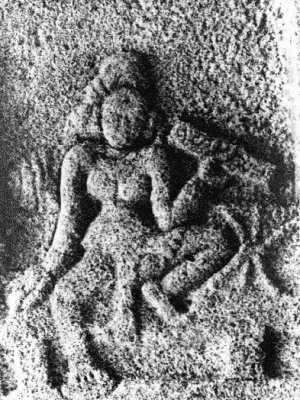Unique Memorial to a Learned Lady
by Jyotsna Kamat
First Online: May 27, 1999
Page Last Updated: December 07, 2024
Margal is a small village about 8 kilometers from Kolar (locate - pictures), head quarters of the district of that name, 70 km. south east of Bangalore in Karnataka Though the place boasts of world's deepest gold mines, Margal apparently does not contain anything special. But inside the village lie scattered, the hero-stones, sculptured stones erected by the people centuries ago to commemorate the glorious dead, who fell fighting in the battle or while facing wild beasts, or saving their cattle from the raids. Some of the sculptures depict scenes helpful in reconstructing social history of the period. But the outstanding sculpture is the one which introduces a remarkable woman-scholar of the 10th century, Savinirmadi.

The memorial, half buried in the middle of a field was partially visible when discovered recently. After proper digging and cleansing, a figure in stone of a young lady was revealed. Seated on a coach and leaning on a cushion, she is depicted in a preaching posture. The figure is neatly dressed in a sari with flowing pleats. Very few ornaments could be identified as the stone appears worn out at places. Her thick hair is arranged in a top-bun.

In the left hand, she is holding a palm-leaf book with Kannada letters..." Shri Hari (a) Siddhi" with one finger carved as concealing the letter ra or ri.
Above the sculpture, a two-line inscription is
engraved in Kannada characters of 10th century. It states that
Savinirmadi, the daughter
of Nagurjunayya and Nandigeyabbe was learned in all the sastras .![]()
In medieval Karnataka, examples of learned women were not rare though the details regarding mode of educating women are not forthcoming. Many of the queens and princesses of the Chalukya- Hoysala times were well-educated. Some excelled in music and dance, some in the skill of weapons and some shone as administrators. (See: Status of Women in Medieval Karnataka). The feudatory kings could also boast of talented women folk, whose versatile qualities find mention in the inscriptions of their times. Shantala's name is too well-known.
But these women belonged to the elite class who had access to all the facilities of education available during that period. We rarely come across commoners who shone in the field of fine arts or studies. Savinirmadi who was a commoner, must indeed have been a unique scholar that people of those times deemed it fit to erect a stone to commemorate her.
The fact that only the name of her parents is mentioned leads one to presume that she never married. Considering ancient milieu this is puzzling. If she were a nun, details of the religious order to which she belonged would have found mention is the inscription and not her parentage. Since the memorial does not form part of the royal decree or donation (as was the usual practice), there is ground for assumption that the grateful people of her locality who were greatly benefited by her specialization in many shastras, --religious and utilitarian, erected this stone to perpetuate her memory.
Those were not the days of mass-education; printing was unknown and most of the knowledge was imparted orally and memorized methodically. A learned man or woman, who had mastered palm-leaf books of different shastras could influence the society a good deal in religious and secular matters.
Such a rare portrait in stone of a remarkable lady-scholar has been lying in an open field, half buried, exposed to harshness of sun and rain and utterly neglected. Though Lewis Rice, the famous epigraphist, had noticed it decades earlier, it failed to draw the attention of historians, archaeologists and lovers of art so far. If left neglected and unattended after being spotted, it is prone to vandalism and a unique memorial would be lost forever. It is hoped that the archaeology department would remove it to a place of safety and more light will be thrown on the sculpture and education of women in ancient times.
![]()
![]() Update January 2000. After Dr.Kamat ,and a fellow
researcher, Dr. Seshasastry published this research, the memorial stone
has been preserved at the University of Bangalore.
Update January 2000. After Dr.Kamat ,and a fellow
researcher, Dr. Seshasastry published this research, the memorial stone
has been preserved at the University of Bangalore.
See Also:
-
Topics on Karnataka -- History and culture of this Southern state.
-
14th Century Women -- article on the status of women in medieval India
-
Women of India -- a large collection of pictures and stories on the Indian womanhood.
![]()

|
Jyotsna
Kamat is a medieval Deccan historian living in Bangalore. Her areas of interest
include women's studies, history of common people and contemporary women's issues.
See her weblog Amma's Column. |
